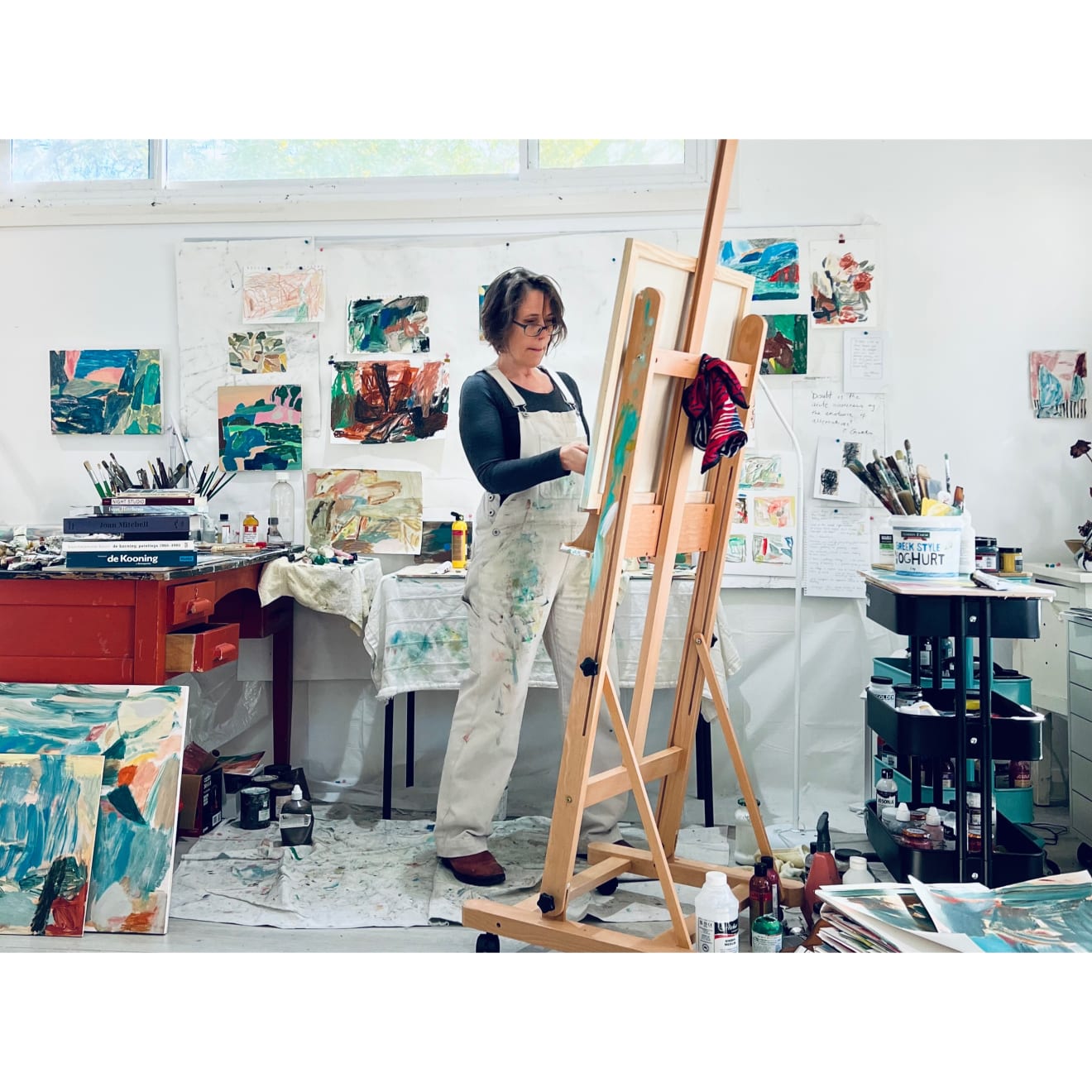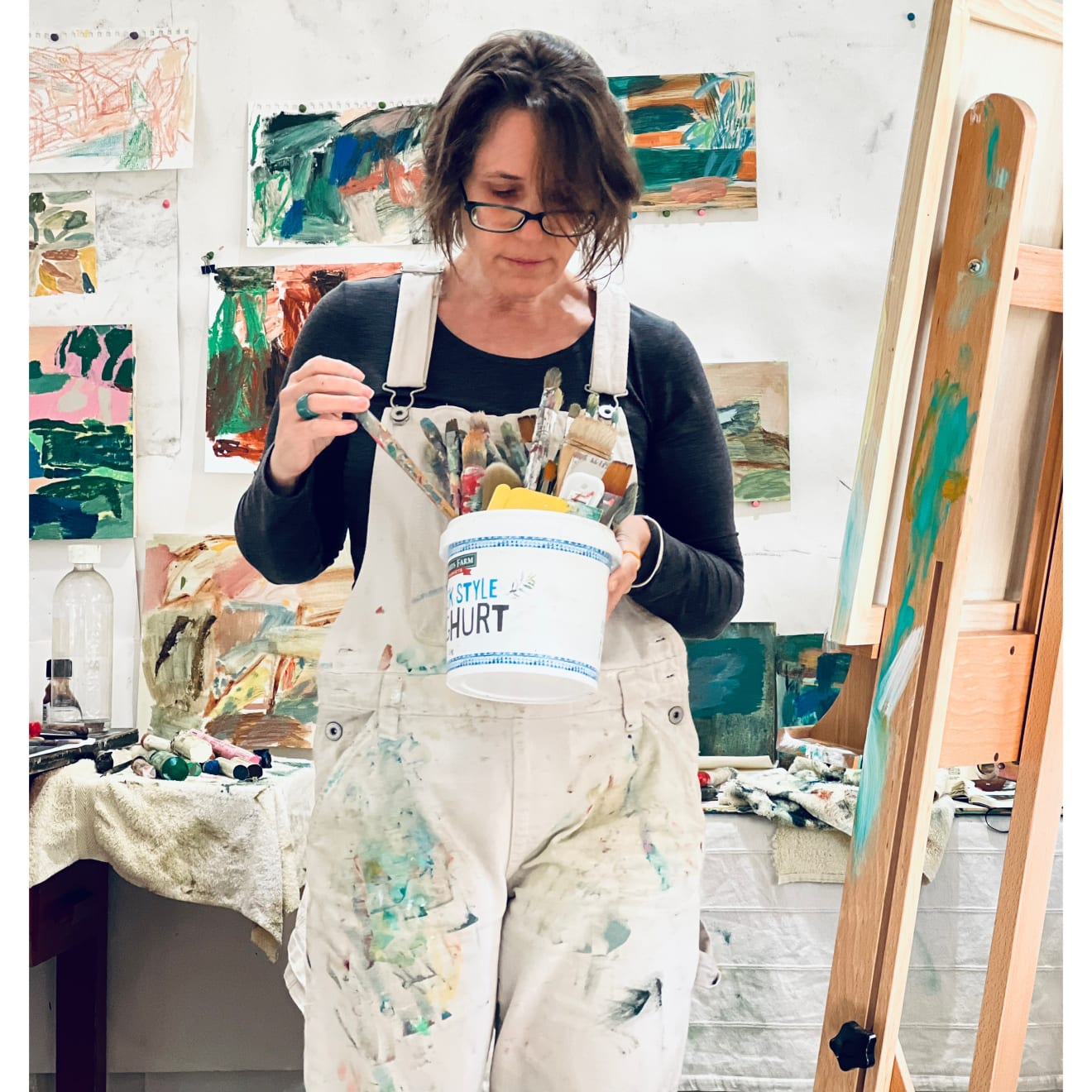My childhood home was on the Northern Beaches of Sydney, overlooking the blue ocean. Growing up around such natural beauty has had a profound impact on me. The glittering water and flickering of light between the gum trees seems to be imprinted on my mind. I remember looking at the swaying trees and marvelling at the different shapes and colours they produced. I am more concerned with how something is, rather than what it is, which is a phrase I read in relation to the work of Lois Dodd that resonated with me.
In Conversation with Inga Dalrymple
In conversation
"I use colour to create spaces that the viewer can move into, around, up and through." - Inga Dalrymple
Otomys is thrilled to welcome Inga Dalrymple to the stable of artists. Inga is a Syndey-based artist whose dynamic and vibrant abstract paintings embrace the abstract quality of memory. We sat down with Inga to learn more about her influences and peel back the layers of her incredible art practice.
OTOMYS: We are curious about the type of music, poetry and ‘other worlds’ that inform your practice. What are the ‘other worlds’ that you are inspired by?
Inga Dalrymple: Music is very important to me. I let the music guide the rhythms of my thoughts. Recently I have been intrigued wth pulsing beats and the visual rhythms that this created within my artworks.
One of my favourite poets is Emily Dickinson. I greatly admire the way she strings words together; her compositions are so peculiar, visceral and haunting. As I delve into her words, I am transported to a world of her creation. Her ability to evoke different moods and images of places and experiences is unparalleled. Although her words do not change, each reading invites a different experience, awakening me to something new. However, her stories can also be quite elusive. I believe that words are synonymous with colour choices. Like words, colour can evoke harmony or discord. Colour combinations behave like sentences, creating unfolding narratives and visual journeys. Sometimes a juxtaposition of colour can create an strange yet beguiling narrative.
OTOMYS: What is the role of narrative within your abstract art?
Inga Dalrymple: I recently came across the word ‘palimpsest’ when reading about the artist Roy Jackson, and it strongly resonated with me. A palimpsest is typically a manuscript that has been reused or altered, but still bares the remnants of its earlier form. The notion that an object can contain traces of a past purpose was powerful. I liked the metaphor that the palimpsest embodies; the notion that we must work with what has come before. In this sense, the theme of my work is related to memory. I traverse the line between what is real and what is not.
Narrative influences my works in the sense that I am inviting conversations through my mark making. Whether that be between the viewer and the work, or between each of the formal elements, such as form, colour, line and shape. There is an element of travelling through, between and around the past that I am attracted to. These encounters with the past create interesting narratives and tensions. Words intrigue me but I am happier describing experiences through paint.
OTOMYS: Can you tell us about your creative process. How do your paintings evolve both aesthetically and conceptually?
Inga Dalrymple: There's no beginning or end to my process. I move rapidly around several surfaces, such as sketchbooks, blocks of paper and several prepared canvases or boards. I usually start with washy marks and build up the composition from there. It’s liberating to explore and allow things to happen organically. But with this experimentation, there is always an element of conscious decision making. Over the years I have developed a friendship with paint. I love how it is so plastic, mouldable and forgiving. I like painting on a solid surface and will often scrape back the paint, revealing the texture of the support. I love the pentimenti of the surface that comes before. It’s so important to me that my paintings breathe. When they don’t, I scrape back the paint and start again.
OTOMYS: You have said that your landscape abstract art responds to memories, emotions, landscapes and places. Are there any specific memories, emotions or places that your paintings encapsulate?
Inga Dalrymple: I don’t aim to physically represent landscapes within my pantings, however, the landscape is constantly present within my work. I like to take in my surroundings as I travel around. In many ways these memories and experiences subconsciously inform my paintings. Observation is an important part of life for me. I take pleasure in noticing the subtleties of my environment, whether it is the colour-faded sign on the side of a brick wall, or the last minutes of daylight projecting the silhouettes of dancing trees onto the grass.
The act of remembering and layering a present perspective on top of an old memory is an important part of my practice. In many ways, this acts as a way of reinterpreting and reimagining the past. I love the place in-between past and present. However, there is also an element of sorrow too. Memories can be sad and haunting. We try to remember the best version of events, but there is still an ambiguity.
Again, I don’t consciously paint emotions. Instead, I want to provoke an emotional response from my paintings. Painting can be difficult, but I do not want my compositions to look laboured. I subscribe to Matisse’s attitude that a painting should be experienced as if it were a comfortable armchair. I use colour to create spaces that the viewer can move into, around, up and through.
OTOMYS: What is the importance of texture and materiality within your practice?
Inga Dalrymple: I think you have to make friends with your materials, otherwise they will work against you. I don’t like arguing with them. Instead I seek out harmony and flow. But I also like the tension that comes when an accident creates something strange and off kilter. To this end, I do a lot of experimentation. Often this will result in failures, but this is all a part of the process. My works are usually on the smaller side because I like the ‘thingness’ of a small work. I respond to the hermetic quality of a smaller scale. It creates an intimacy that large scale works can’t achieve.
To enquire about Inga Dalrymple's work please contact info@otomys.com.
Click HERE to read more interviews with our Otomys artists.
August 9, 2023



